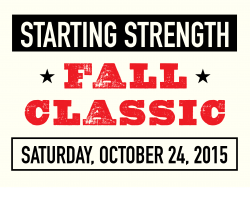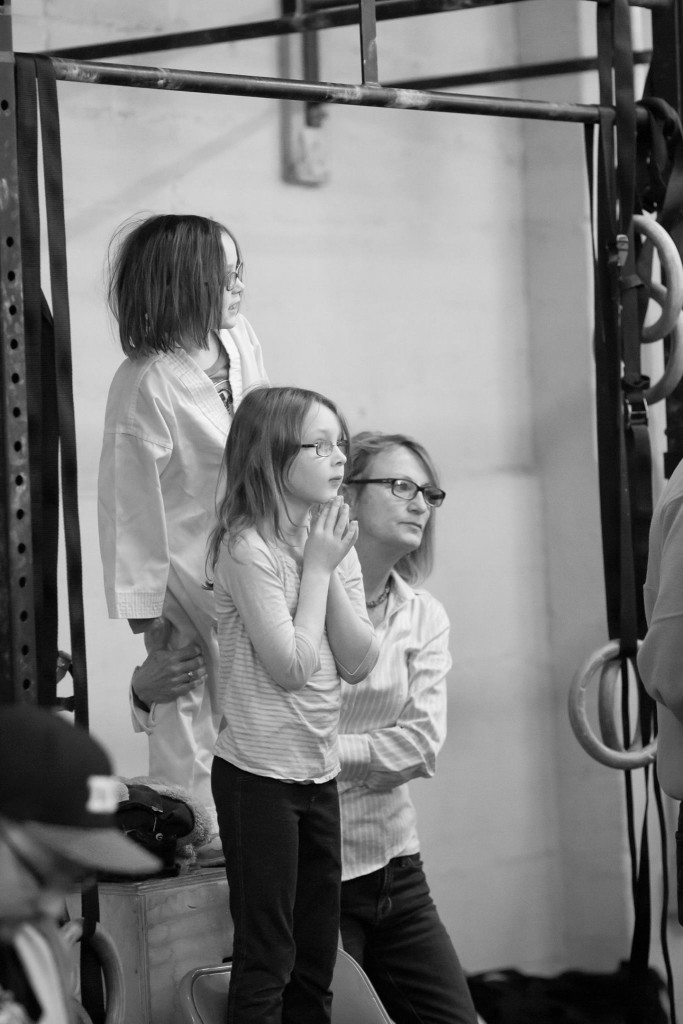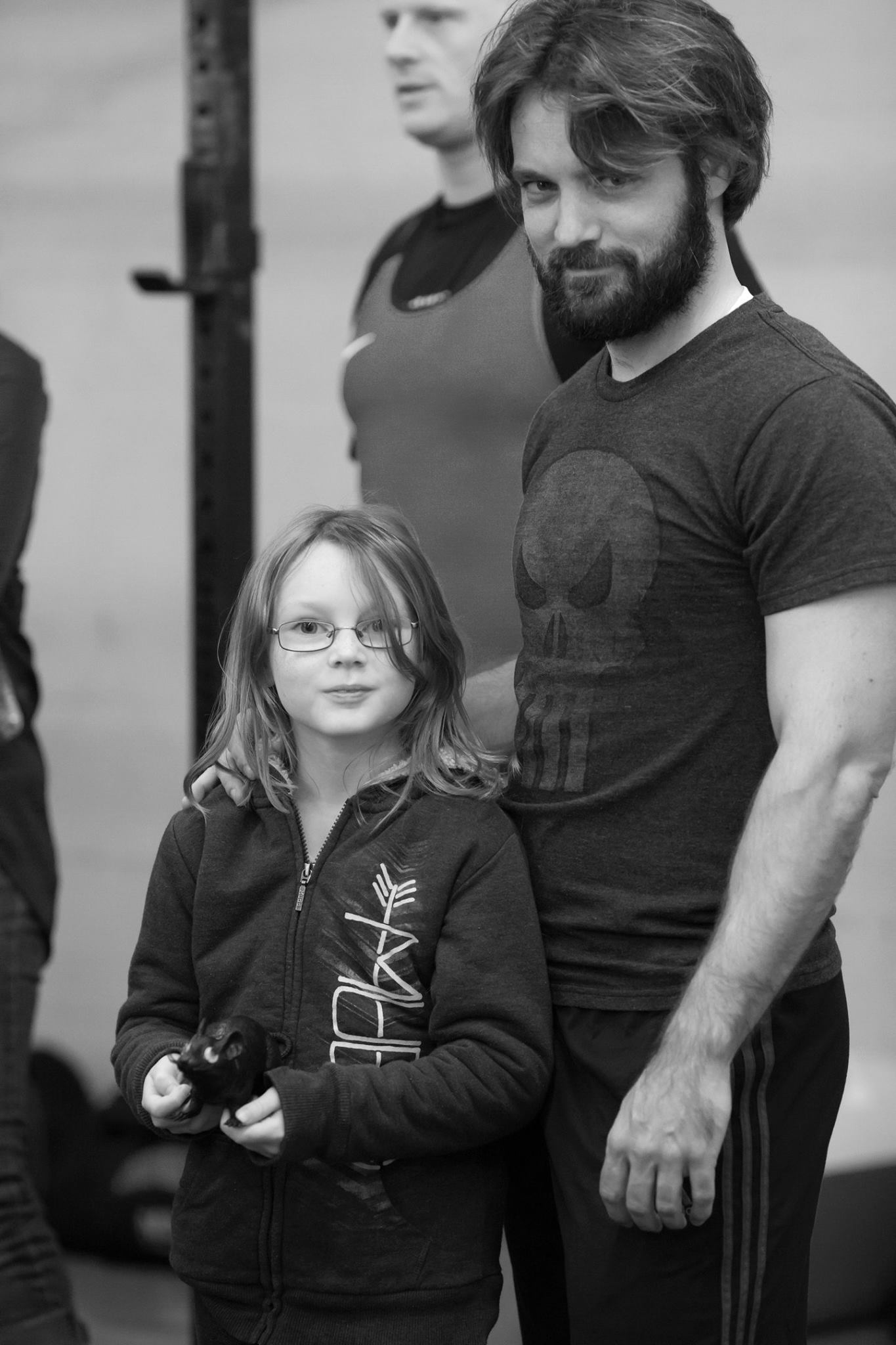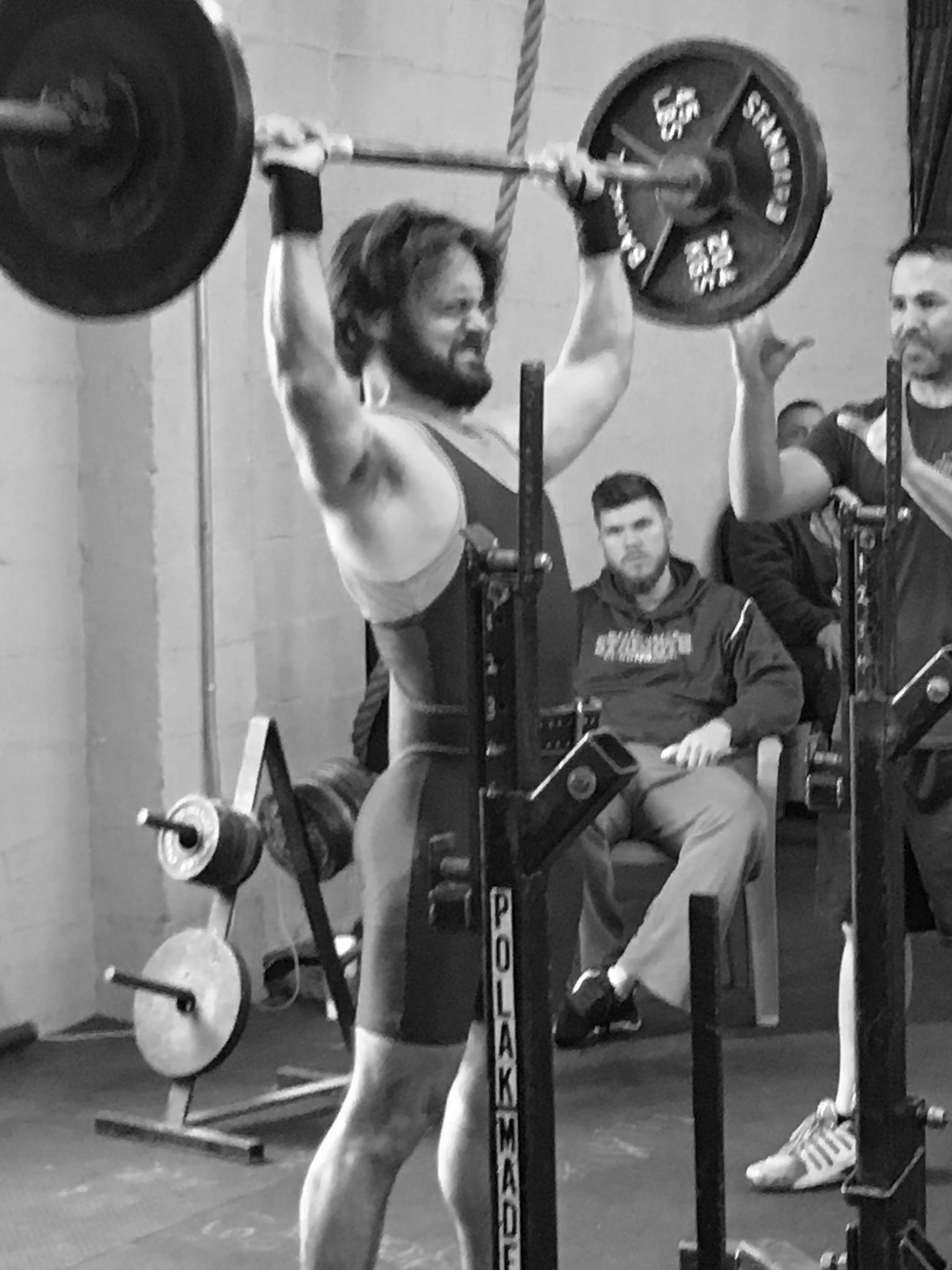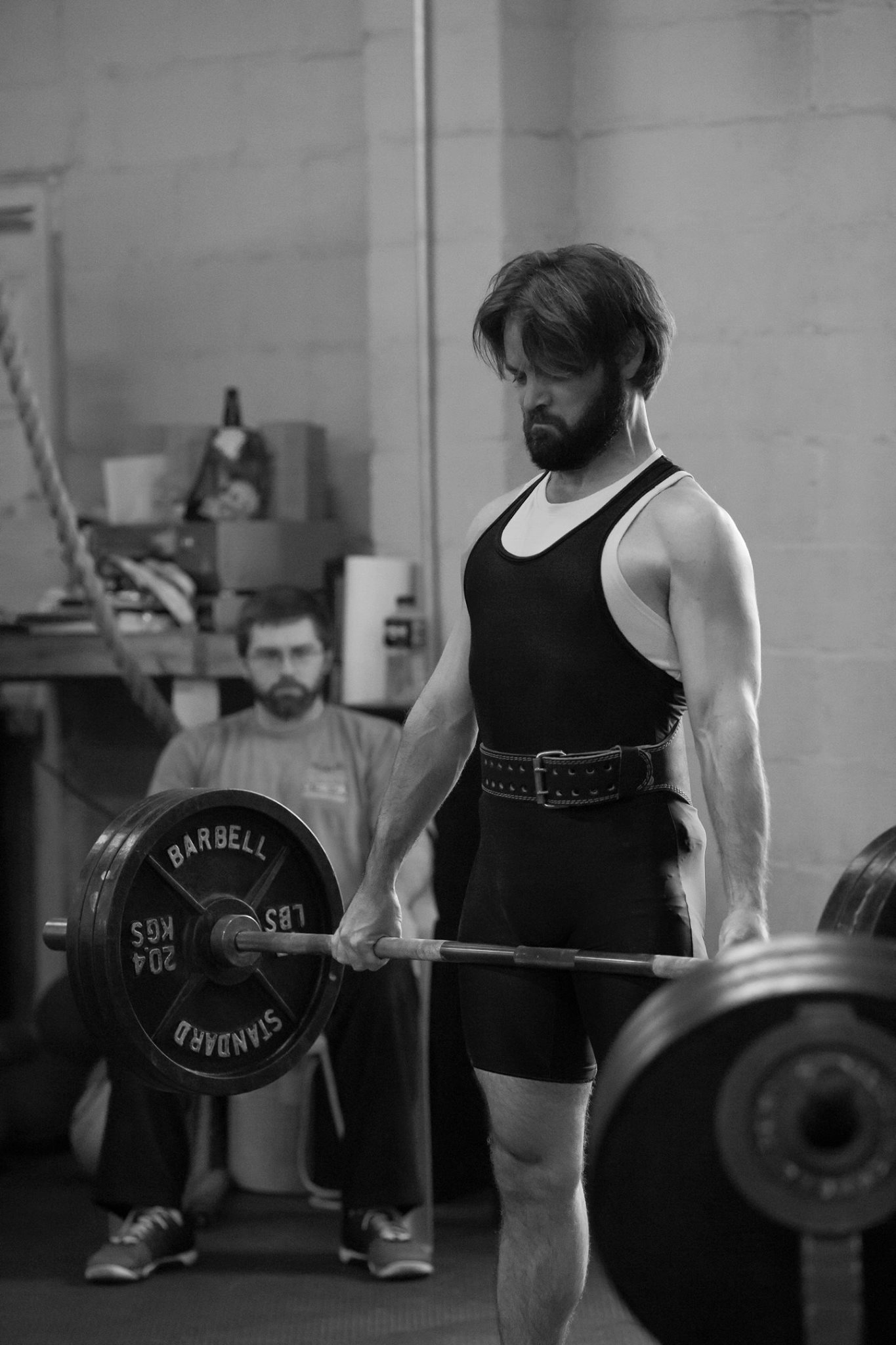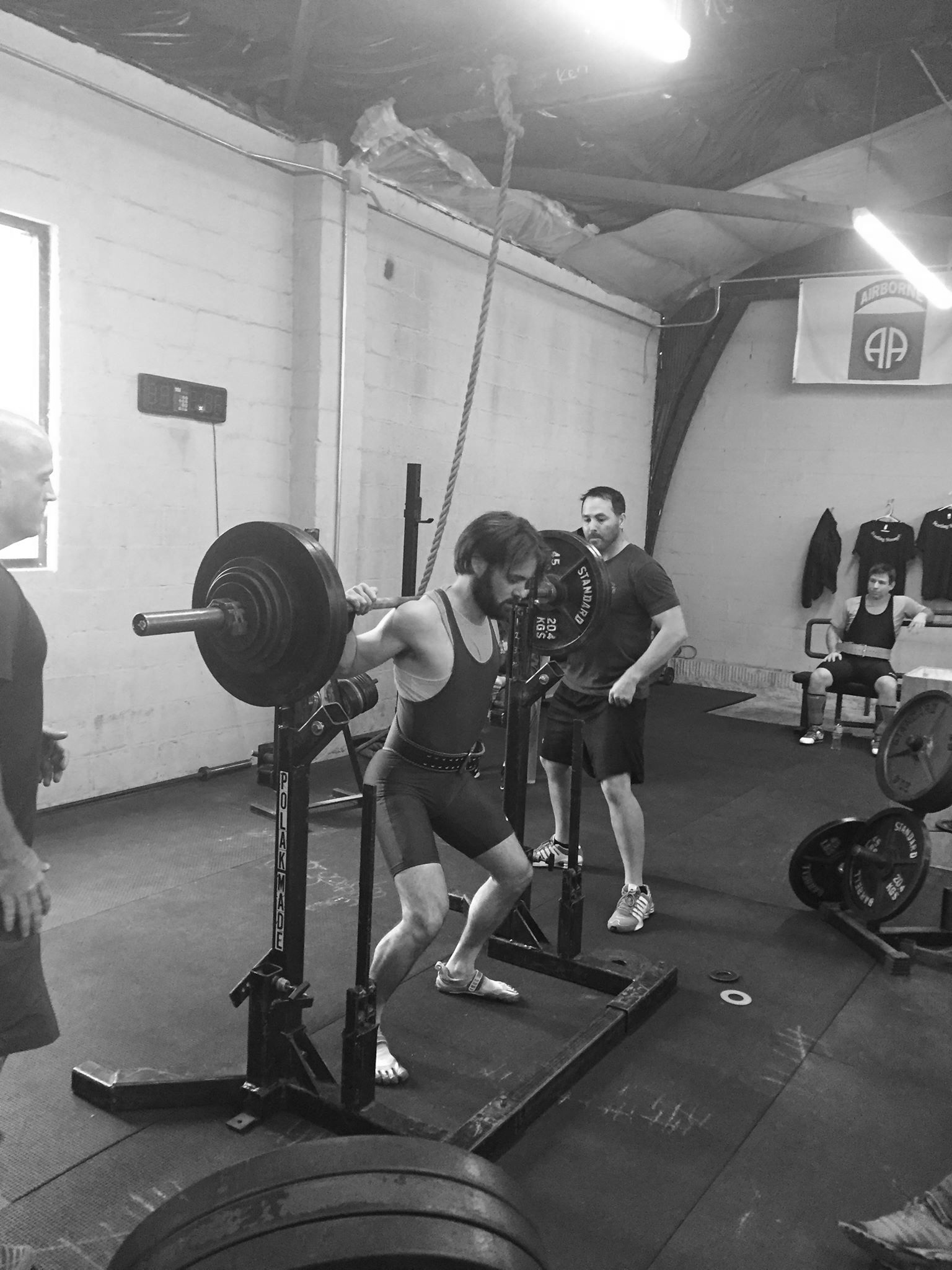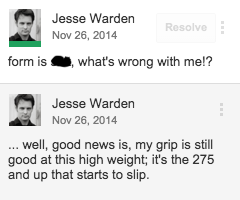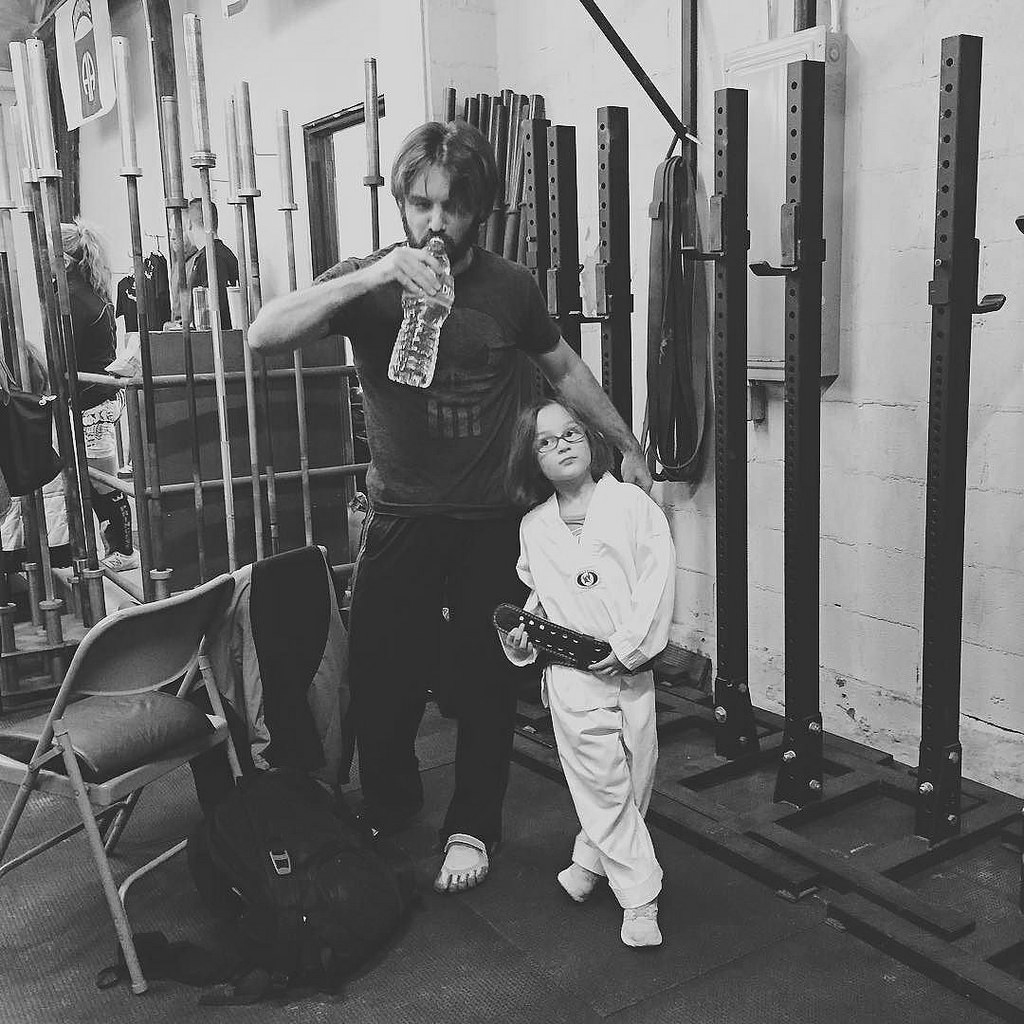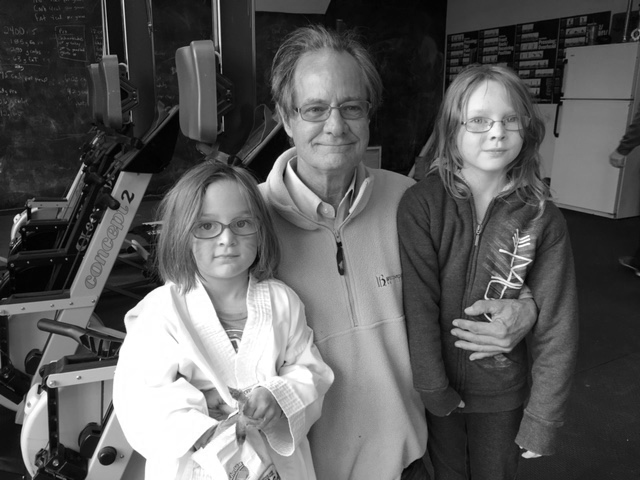I attended my first Powerlifting competition last weekend called the 2015 Starting Strength Fall Classic. I played baseball and soccer as a kid, but didn’t participate any sports past elementary school. Therefore this was quite a special event for me for a variety of reasons.
My original motivation was knowing I was probably seriously outmatched, I persevered to train hard for over a year and attempt to “win” anyway. After hearing my older daughter bow out of a swim race because she was convinced she’d lose so didn’t even want to try only galvanized it for me. As a father, it was my responsibility to show you do NOT give up, nor fear failure, regardless of the odds. You work hard and try. That’s it, no negotiation.
I thought I’d write how it went, what my training was like leading up to it the past 18 months, and fitness plans for the future.
Glossary:
Rep: Short for “repetition”. If you pick up a 10 lb dumbbell and then put it back on the floor, that’s 1 rep. If you do this 5 times, that’s 5 reps.
Set: If you do 5 reps then stop to rest, that’s 1 set. If you do 5 reps, rest, then 5 reps, then rest, that’s 2 sets.
x format: If you document that set, it’d be written as 2x5x10 which means “2 sets of 5 reps with 10 lbs”.
What is Powerlifting?
I’ve been doing Powerlifting for about 2 years and didn’t know it was called that until 1 month before the event. Basically, Powerlifting is lifting weights using only barbells doing 3 specific moves: The Squat, Bench Press, and Deadlift. The goal is to lift as much weight as possible, and barbells are the most efficient way for the body to do that in an exercise context. At a competition, you lift the weight for 1 max rep (as heavy as you can go one time), and have 3 tries to see how much you can lift. Most lifts are generally slow.
Starting Strength, the beginner’s book and program to get into Powerlifting, incorporates 2 optional additional lifts: the Overhead Press and the Power Clean as well as various accessory exercises and variations if you’re mature enough to use them.
Is that Weightlifting?
No. It’s actually a horrible name because Weightlifting (also called Olympic Lifts), which does the Snatch and the Clean and Jerk, actually generates more power than Powerlifts. They’re also a lot trickier to do, and you can screw up lifts more often, called a miss, since it requires a lot more coordination than Powerlifting lifts. That’s why they’re performed in the Olympics.
Is It Like Bodybuilding?
No. Body Building is similar about strength gains, but the goal is muscle hypertrophy: get bigger muscles with low body fat to show them off. There isn’t a huge incentive to lower your body fat too much in Powerlifting because you want enough nutrients and calories to build muscle to grow strong and recover. At a Powerlifting competition, we’re judged on how much we lift, not what we look like or how we pose.
In fact, Powerlifters have a reputation as either having too much body fat, or just not looking strong because you can’t easily see their muscles. Most of us make any excuse to bulk year round.  That’s one of the reasons why I looked much better during Body Beast than I do now despite the fact I’m much stronger now. Her majesty and my mom were quite shocked at the 30 or so women of all ages at the competition not looking “jacked”, yet capable of great strength. They looked like normal women.
Bodybuilding is typically isolation exercises at higher volume with lighter weight, whereas Powerlifting is compound exercises at lower volume with heavier weight. Meaning, you do a bunch of reps that only use 1 muscle or group of muscles like bicep curls to really work that muscle/group hard, then give it a break to heal and grow bigger while you focus on another group. While you’re technically getting stronger because bigger muscles equal a stronger muscle, you’re also gaining endurance doing that many reps.
In Powerlifting, you’re doing less reps on a move that targets all muscle groups, with a lot more weight often with longer rest times between sets. Different factors like neurological connections better recruiting what you have, stronger bone and tendon connections, and overall stiffer tissue are what is developed more in Powerlifting exercises.
For programmers, think Bodybuilding as upgrading 70% of the hardware, 30% of the software whereas Powerlifting is 70% software, 30% hardware.
Competition Rules
The Starting Strength competition is slightly different in that they do the Overhead Press, often called just the Press, instead of the Bench Press. They’re also less strict about certain clothes and gear. No lifting straps, though, for deadlifting I found out last minute, heh. MOAR CHALK. While you’re encouraged to wear shin covering socks for deadlifts in case you scrape your shins as they prevent bleeding all over the bar, I got away with wearing my Vibrams with no socks.
Aside from those 2 things, everything Jordan Syatt talks about in his Beginner’s Guide to Powerlifting was accurate. I followed what he outlines and I was glad I did.
Supporting Equipment
There are 2 camps: gear and raw. If you’re raw, you believe that being basically naked, you should lift weight with nothing more than what you were born with.
Gearheads like me believe you should be allowed to use whatever equipment necessary to lift more weight, and thus get and be stronger. While I don’t have shoes yet, compression shirts, nor knee straps, I do use a belt and wrist wraps. When at the gym, I alternate between gym chalk for better grip and wrist straps (these are different than wraps) for deadlifts.
I saw both camps at the competition, and it was impossible to tell if it made any difference for the competitors.
Competition Opener
At a competition, you do the 3 lifts. You get 3 tries for each lift. It depends on the event, but I got about 2 minutes rest between each attempt. I’m used to taking a 4 to 5 minutes rest. You have to calculate your opener for each lift: what weight will you start at. Typically this is supposed to be lower because you’re probably nervous or stressed out and the gym plus equipment there are different than you’re used to. You’re put into a group called a “flight” that’s near your weight and gender. Age doesn’t matter but is taken into account for scoring I think.
My openers were 300 lb / 136 kg for Squat, 135 lb / 61 kg for Press, and originally 365 lb / 166 kg for Deadlift. However, once I found out I couldn’t use straps, I lowered it to 300 lb / 136 kg.
I was extremely nervous and shy and slightly embarrassed many days before and while at the meet. I originally was going to go as a Super Saiyan with gelled up, dyed blonde hair to compensate since at least everyone would want selfies with me even if I couldn’t lift as much as they could. I opted to look like Goku instead with blue and orange singlet and shirtthanks to her majesty’s idea. Gave up spiking my hair like Goku’s since I was so tired from the drive the night before & morning. I also found out you’re supposed to wear your shirt under the singlet, not over. I deftly fixed it once I noticed everyone else while warming up.
Final Results
As someone who speaks a lot at user groups and conferences, I get jazzed up in front of crowds. I think that positive energy allowed me to perform well. Despite not working out 2 weeks prior, traveling overseas, then to 2 different places at the east coast, all over 8 days with crappy sleep the night before… I felt pretty good that morning. However, like what usually happens during a heavy lift, my mind leaves the present so I didn’t hear any of the yells of encouragement nor clapping of the crowd… but apparently it was there as I watched videos of myself later.
You can view all the results in the Men Open sheet.
While I’ve squatted more, my final Squat was 322.5Â lb / 146 kg.
My Press was 140 lb / 63.5 kg as I failed my 3rd 145 lb / 65.8 kg attempt because my grip was too wide.
My Deadlift with only chalk was 370 lb / 168 kg, a new record (also called PR or PB for personal best) for me.
Learnings
Nine things I learned, beyond Jordan’s article being extremely helpful.
You Are the Most Challenging Competitor
First, no one there, myself included, seemed to be competing with each other. Like Jordan said, you’re competing with yourself, seeing if your training paid off. Your either curious about last year’s competition, or your training goals to prepare for next years competition. This was VERY clear from watching the bigger vets. They were quiet, focused, and clearly in the zone, even during warmups.
What You Weigh Doesn’t Matter
Second, weight doesn’t matter. This nice guy, Nickola “Nick” Crnjanski, weighed almost 20 lb / 9 kg less than me, yet killed me on his ratios. Some of the big boys who came in later in the day weren’t that much larger, but boy did they lift some heavy weights without breaking a sweat. It’s clear practice and hard work, over YEARS, pays off.
Years, Even Decades of Work
Third, again, it’s clear that to get really strong, you have to invest years into the sport. While I’ve done a lot of exercise programs and diets, it appears regardless of which one I choose, I’ll get the best results if I do it for years vs. “90 days” or “6 months”. Starting Strength was the only one that clearly mentioned that: “You can do this for the rest of your life and continue to get strong if you want to.”
Body Builder to Strength Builder
Fourth, once I reached the 6 month mark of Starting Strength, I stopped caring a lot about how I looked. While I still played around with macros and intermittent fasting I was more concerned with strength gains. I found that, at least for me, intermittent fasting caused me to not eat enough calories for the day. I’d either get starving at night, or just not be able to fit enough food in during 1 meal.
As a business traveller, even though I pack my own food, it’s hard to fit it into my hectic work and sleep schedule. I still think I’ll switch to high protein, low carb cut diet next summer again… or maybe not. Either way, taking selfies to see progress of the diet and workout routine is less of a priority. All I care about now is constantly improving my form and tracking my numbers so I know if I’m improving or not. Cutting calories and stressing about food doesn’t help those goals.
Do It Right, Growth Will Occur
Fifth, once I got my form right BY NOVEMBER (yes, 7 months of trial and error… stupid attention span), growth happened a lot. My chest and especially my shoulders a little bit as you can see from the measurements I did grow a lot in just 4 months… but my thighs… MY THIGHS. 1 inch. Now, I’m a small guy, but suddenly NONE of my jeans except for an insanely bagger pair fit. All my work slacks were tight around the thighs. While I can survive in my work clothes, my casual outfits no longer work.
While my belt will shrink a notch in the summer, and grow a notch during the winter months, my waste has remained a steady 33 to 34 size since completing my 1st round of P90X. It’s clear I’ll have to buy either “loose fit” jeans from now on, or 35/36 sizes. I should also point out NOT fitting into my clothes by getting “not-fat” in P90X was an awesome feeling. Now, not fitting because my muscles are getting bigger is also a good feeling… just… different.
Big Bootay
Six, and yes… this is separate from fifth, I got a lot more junk in the trunk. Her majesty reminds me often. While it’s cliche in social media image memes talking about how “she squats” apparently that doesn’t happen to women much since they don’t have the growth guys have because of testosterone. Thankfully the pants adjust here.
The boxers, sadly, do not. I average 1 pair that splits every 2 months now. When it first happened I thought I hurt myself so bad because the rip was so loud… and then realized it was my pants and was so embarrassed I had to abort the lift. Thankfully my workout pants were fine, but now when it happens I just power through and lament the loss because they can’t take the butt power.
Lumberjack
Seven, in my young 20’s I was never able to grow a beard. Now it takes less than 2 weeks. It’s clear working out like this increases it. I keep telling myself it’s that and not a natural occurrence of getting older.
Document Your Progress, Keep A Journal
Eight, keeping a journal beyond just your numbers, or even just writing comments about how certain workouts or exercises went is extremely helpful both short and long term. Week to week I remind myself what to practice on. Months and years later, I can get UBER inspired by overcoming what I thought were insanely hard, near impossible challenges. For example, here’s a comment from last year, November 26th:
275 and up is hard? HARD!? I did 370 last Saturday. Isn’t that comment ADORABLE!?!!11oneone
Women Who Lift
Nine, it was rad watching the women lift. They’re all nice & happy, and then suddenly get all mad and red in the face with everyone cheering them on. One of the women running the event, a former runner and gym teacher, was helping me to try and convince my mom to compete next year. For context, my mom is 64 running her 2nd half marathon next week. She swore she’d never run another one, hah!
Training
Random Progression
I’ve been doing Starting Strength like exercises MOSTLY correct since March 23rd, 2014. So 19 months. After Body Beast I kind of just made up my own routine for a few months. It felt good, but progress was slow and I wasn’t really sure if my plan was good or not for body building maintenance.
The Big 3
After that I started Andy Morgan’s Big 3 routine at the behest of my jacked friend Leonard Souza who’s also a Science Fiction writer. However, I was doing 5 sets instead of 3 with a curl bar instead of a barbell because I couldn’t afford to buy new equipment again. For safety reasons, I was using dumbbells for bench press. For un-safe reasons for squats, I was using 2 chairs anchored by heavy dumbbells, cushioned by yoga matts as a make-shift squat rack. Ghetto, but it got me from 120 lb to 180 lb. For bench, some of my data actually shows single dumbbell usage vs. double what it should be (i.e. 5x5x35 instead of 5x5x70). I also didn’t start to do warmups for anything until 6 months in (whoops).
Starting Strength
Leonard had me read a few books, and one of them was Starting Strength 3rd edition. I only read part of it, but unlike P90X which had a very clear schedule laid out, it was hard to understand what to do when. By the third time I re-read “most” of the book + online resources that talk about it, I had a steady, 3 day a week routine down. The only cardio I do now is playing with my kids on bikes, the pool, or short runs with the new dog. I never stretch anymore. I only get sore if I’ve taken longer than a week break, start nearing the 290 lb squat barrier, or do >310 lb deadlifts consecutively. Even if not sore, the # increases prove you can get stronger without feeling uber sore.
I now follow the book to the letter schedule wise, and later this winter hope to play around with some of the modification exercises because some of my lifts are stuck. Crazy it took me 18 months, but I bet if I had a better attention span and read the whole book through slowly, it would of only taken 8, heh! That and this is a hobby that’s NOT on the computer. I’m obsessed with programming so it’s hard to share my attention.
Current schedule is Squat, Bench, Clean, weighted Chin Ups, then 1 day later Squat, Press, Deadlift, weighted Pull Ups. Typically Wednesday, Friday, Sunday, then Monday, Tuesday, Thursday, and Saturday are rest days. You just do that for months until you plateau and either take a week or 2 to rest, or try something new.
Future Goals
For example, after about a year, I wanted to see if I could break through my squat plateau AND boredom, so tried a few of Alan Thrall’s suggestions for when you stall on a 3×5/5×5 plan. They didn’t work, but they didn’t weaken me either according to my numbers. What they DID do was give me something new and fun to try that was a lot more volume than I was used to. I’ll probably try them again as well as some of his other suggestions since I’ve noticed it takes me a few tries to do some of these complicated things correctly. Ensuring you do SOMETHING instead of quitting is important so it’s better to pause your training if you’re burnt out, just like programming. You can take a break without sacrificing progress.
I seriously want to give Smolov a try mainly because everyone says not to. Hard to do with my travel schedule at that level of intensity. That’s why Starting Strength is so appealing with my schedule; just 3 days a week in about an hour.
I really need to re-read Greg Nuckols’Â complete strength guide as well. That guy can nerd out pretty hard, but like Andy, he’ll sometimes surface diamonds of knowledge. You sometimes just have to dig.
After 1 more year of training, I’m going to CRUSH my numbers at the next meet. Hell, I may even start running again. I feel less and less guilty each day about not trying P90X3. Maybe that’ll be a break for me, hah!
Patience & Persistence
One thing I learned from plateauing a bunch is patience. It’s been so wonderful to know if I just do my best, consistently work hard, and sleep enough… the plateau just “goes away” one day. It’s harder for me because I haven’t bought the 1 lb, 1/2 lb, and 1/4 lb plates like the book says I should, but if you don’t have those, I’m here to tell you patience and persistence DOES pay off. It’d be faster if I used the tiny plates.
Progress Chart
Although you can see my numbers from last year and my 4th round, I’ve created a chart below from a sample of data that show’s total progress on all lifts. Considering I’m a stressed, traveling workaholic that doesn’t always sleep well, I’ve done pretty good. I DO make sure to eat right and have willpower so I think that’s where its helped.
- Squat
- Bench
- Deadlift
- Press
- Clean
Conclusions
It was a well run event. It was wonderful to have my parents, wife, and daughters watch and support me. Overall a great experience. I can’t wait to be stronger next year, hopefully with my stronger mom competing with me.
